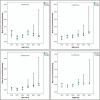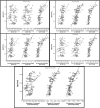Corneal clarity measurements in healthy volunteers across different age groups: Observational study
- PMID: 29145265
- PMCID: PMC5704810
- DOI: 10.1097/MD.0000000000008563
Corneal clarity measurements in healthy volunteers across different age groups: Observational study
Abstract
The aim of this study was to standardize and investigate the changes in corneal clarity with age. Densitometry software for the Oculus Pentacam was used to examine corneal clarity at different age groups.A total of 192 eyes from 97 healthy participants were included in this cohort comparative nonrandomized, cross-sectional study. An Oculus Pentcam was used to image the cornea of healthy participants grouped by age (between 10 and 70 years old). Data from the densitometry output have been used to determine clarity in concentric zones and different depths of the cornea.Corneal densitometry (CD) across all ages showed significant differences between groups when divided into the following layers: anterior, central, and posterior or divided into 0 to 2, 2 to 6, and 6 to 10 mm concentric zones (P < .05). The most striking decrease in clarity occurred with age in all 3 layers of the periphery (6-10 mm) (P < .05). In addition, we showed that the 10 to 19-year age group had lower clarity than the 20 to 30-age group (P < .05), and after 30 years, the cornea shows a steady progression of increased or decreased clarity.The values for CD, as well as for separate subdivisions based on layer and surface area, might provide a standard for use in further studies and clinical practice. This study established that relation between CD and age is differed when the cornea is divided into layers and zones. This study suggests that there are other factors that may play an essential role in corneal clarity as well as age.
Conflict of interest statement
The authors report no conflicts of interest.
Figures
Similar articles
-
Normative values for corneal densitometry analysis by Scheimpflug optical assessment.Invest Ophthalmol Vis Sci. 2014 Jan 7;55(1):162-8. doi: 10.1167/iovs.13-13236. Invest Ophthalmol Vis Sci. 2014. PMID: 24327608
-
Corneal densitometry and its correlation with age, pachymetry, corneal curvature, and refraction.Int Ophthalmol. 2017 Dec;37(6):1263-1268. doi: 10.1007/s10792-016-0397-y. Epub 2016 Nov 11. Int Ophthalmol. 2017. PMID: 27837355
-
Quantitative assessment of corneal clarity in keratoconus: a case control study of corneal densitometry.Eur J Ophthalmol. 2016 Jan-Feb;26(1):18-23. doi: 10.5301/ejo.5000644. Epub 2015 Jul 7. Eur J Ophthalmol. 2016. PMID: 26165332
-
Corneal Densitometry: A New Technique for Objective Assessment of Corneal Clarity in Pseudoexfoliation Syndrome.J Glaucoma. 2016 Sep;25(9):775-9. doi: 10.1097/IJG.0000000000000501. J Glaucoma. 2016. PMID: 27513907
-
Assessment of corneal backward light scattering in the healthy cornea and factors affecting corneal transparency.Jpn J Ophthalmol. 2018 May;62(3):335-341. doi: 10.1007/s10384-018-0584-7. Epub 2018 Mar 16. Jpn J Ophthalmol. 2018. PMID: 29549461
Cited by
-
Long-term changes in corneal densitometry and associated factors following small incision lenticule extraction for moderate and high myopia.Front Med (Lausanne). 2022 Sep 8;9:945894. doi: 10.3389/fmed.2022.945894. eCollection 2022. Front Med (Lausanne). 2022. PMID: 36160150 Free PMC article.
-
Quantitative evaluation of corneal epithelial edema after cataract surgery using corneal densitometry: a prospective study.BMC Ophthalmol. 2018 Dec 20;18(1):334. doi: 10.1186/s12886-018-0998-5. BMC Ophthalmol. 2018. PMID: 30572855 Free PMC article.
-
Corneal clarity measurements in patients with keratoconus undergoing either penetrating or deep anterior lamellar keratoplasty.Clin Ophthalmol. 2018 Mar 23;12:577-585. doi: 10.2147/OPTH.S157286. eCollection 2018. Clin Ophthalmol. 2018. PMID: 29615834 Free PMC article.
-
Corneal densitometry in Chinese adults with healthy corneas: associations with sex, age, ocular metrics, and optical characteristics.BMC Ophthalmol. 2024 May 31;24(1):230. doi: 10.1186/s12886-024-03500-y. BMC Ophthalmol. 2024. PMID: 38822272 Free PMC article.
-
Corneal Imaging and Densitometry Measurements in Juvenile and Adult Keratoconus Patients to Evaluate Disease Progression and Treatment Effects After Corneal Cross-Linking.Clin Optom (Auckl). 2019 Dec 30;11:173-180. doi: 10.2147/OPTO.S226000. eCollection 2019. Clin Optom (Auckl). 2019. PMID: 31920417 Free PMC article.
References
-
- Maurice DM (1988) Mechanics of the cornea, in The Cornea: Transactions of the World Congress on the Cornea III, Cavanagh HD, Editor. New York: Raven Press. p. 187-193.
-
- Freegard TJ. The physical basis of transparency of the normal cornea. Eye 1997;11:465–71. - PubMed
-
- Borcherding MS, Blacik L, Sittig R, et al. Proteoglycans and collagen fibre organization in human corneoscleral tissue. Exp Eye Res 1975;21:59–70. - PubMed
Publication types
MeSH terms
LinkOut - more resources
Full Text Sources
Other Literature Sources



